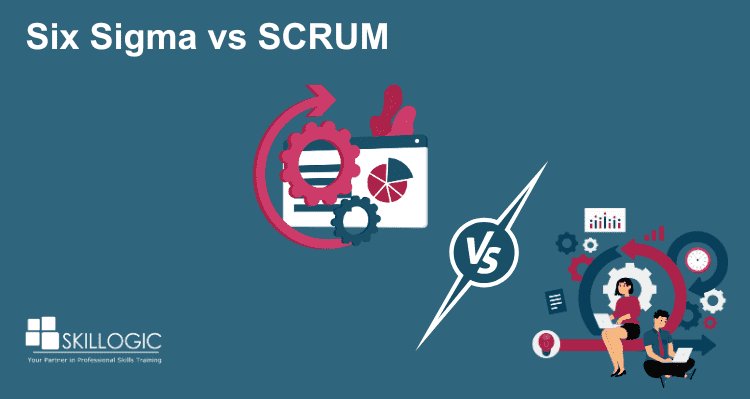Six Sigma vs SCRUM

In the ever-evolving landscape of project management methodologies, two popular approaches stand out: Six Sigma and Scrum. Both methodologies have gained significant traction across industries for their ability to enhance productivity, improve efficiency, and drive quality outcomes. However, their fundamental principles, practices, and applications differ, making it essential for organizations to discern which approach best aligns with their objectives and operational needs.
According to a report by Research and Market, the global quality management software market is expected to reach USD 20.66 billion by 2030, with a projected compound annual growth rate (CAGR) of 10.6% from 2023 to 2030. In this article, we'll delve into the intricacies of Six Sigma and Scrum, outlining their key features, benefits, and considerations to help you make informed decisions for your business.
Introduction:
In today's competitive business environment, organizations are constantly seeking ways to optimize processes, deliver value to customers, and achieve sustainable growth. Project management methodologies play a pivotal role in this endeavor by providing structured frameworks for managing tasks, resources, and deliverables. Among the myriad of methodologies available, Six Sigma and Scrum have emerged as prominent choices, each offering unique advantages and methodologies for achieving business excellence. Pursuing a Six Sigma Green Belt certification can further enhance an individual's proficiency in process improvement and quality management, adding a valuable credential to their skill set.
Read these articles:
- Exploring Essential Six Sigma Tools for Process Improvement
- Complete Guide to Six Sigma Certification
- What is Lean Six Sigma
- Who Is a Quality Manager?
Understanding Six Sigma:
Six Sigma is a data-driven methodology focused on eliminating defects and minimizing variations in processes to enhance quality and consistency. Originating from Motorola in the 1980s and later popularized by companies like General Electric, Six Sigma relies on statistical analysis and rigorous problem-solving techniques to identify root causes of inefficiencies and implement targeted improvements. Professionals can attain expertise through Six Sigma Black Belt certification, which signifies mastery in the methodology's tools and techniques for driving process improvement.
As per findings from a Verified Market Research report, the Quality Management Software market achieved a valuation of USD 7.56 Billion in 2019. Forecasts indicate a potential rise to USD 16.04 Billion by 2027, with an expected compound annual growth rate (CAGR) of 9.9% spanning from 2020 to 2027. Central to Six Sigma is the DMAIC (Define, Measure, Analyze, Improve, Control) framework, which provides a structured approach to process improvement:
- Define: Precisely outline the issue at hand, articulate the objectives of the project, and specify the expectations and needs of the customer.
- Measure: Collect relevant data and establish baseline metrics to quantify process performance.
- Analyze: Identify root causes of defects or deviations using statistical tools and analysis techniques.
- Improve: Implement solutions to address identified issues and optimize processes for enhanced performance.
- Control: Establish controls and monitoring mechanisms to sustain improvements and prevent regression.
Key Benefits of Six Sigma:
- Data-Driven Decision Making: Six Sigma emphasizes the importance of data analysis, enabling organizations to make informed decisions based on empirical evidence rather than assumptions.
- Continuous Improvement: By following the DMAIC framework, Six Sigma fosters a culture of continuous improvement, where processes are constantly refined to achieve higher levels of quality and efficiency.
- Customer-Centricity: Six Sigma prioritizes understanding and meeting customer needs, leading to enhanced satisfaction and loyalty.
- Enhanced Earning Potential: Six Sigma certification can lead to higher earning potential as it demonstrates expertise in process improvement methodologies. Furthermore, the salary of a Six Sigma green belt salary in India and USA ranges from INR 7,20,000 and USD 100,555 per year according to a Glassdoor report.
Understanding Scrum:
In contrast to Six Sigma's focus on process improvement, Scrum is an agile framework designed for managing complex projects and product development. Developed in the 1990s by Jeff Sutherland and Ken Schwaber, Scrum emphasizes adaptability, collaboration, and iterative development.
In 2021, the Scrum Software market was valued at USD 583.5 Million. It is anticipated to achieve a market value of USD 1,138.5 Million by 2030, reflecting a compound annual growth rate (CAGR) of 7.8% according to an Acumen Research and Consulting report.
At its core, Scrum operates on the principles of transparency, inspection, and adaptation, with a strong emphasis on self-organizing teams and frequent feedback loops. The Scrum framework comprises several key roles, events, and artifacts:
- Roles: Product Owner, Scrum Master, Development Team
- Events: Sprint Planning, Daily Standups, Sprint Review, Sprint Retrospective
- Artifacts: Product Backlog, Sprint Backlog, Increment
Key Benefits of Scrum:
- Flexibility and Adaptability: Scrum enables teams to respond quickly to changing requirements and market dynamics through iterative development cycles.
- Enhanced Collaboration: The emphasis on cross-functional teams and frequent communication fosters collaboration and collective ownership of project goals.
- Faster Time to Market: By breaking down work into manageable increments (Sprints), Scrum facilitates faster delivery of value to customers and stakeholders.
Refer to these articles:
- Six Sigma Certification Cost in India
- Why Six Sigma Certification in India?
- PMP Certification Cost in India
Choosing the Right Methodology:
Selecting between Six Sigma and Scrum depends on various factors that include:
- Process Orientation: Six Sigma focuses on improving existing processes by reducing defects and variations, often using statistical analysis and structured problem-solving techniques. In contrast, Scrum is centred around iterative development and continuous improvement, with a focus on delivering value to customers through frequent releases and feedback loops.
- Team Dynamics: Six Sigma typically involves cross-functional teams led by a certified Six Sigma professional (e.g., Black Belt or Green Belt), emphasizing data-driven decision-making and process optimization. Scrum, on the other hand, relies on self-organizing, cross-functional teams known as Scrum Teams, who collaborate closely to deliver incremental improvements and adapt to changing requirements.
- Customer Engagement: Both methodologies prioritize customer satisfaction, but they approach it differently. Six Sigma emphasizes understanding customer needs and aligning processes to meet those needs effectively. Scrum involves regular interactions with stakeholders, incorporating their feedback into the development process to ensure the end product meets their expectations.
- Flexibility vs. Rigidity: Scrum offers greater flexibility and adaptability, allowing teams to respond quickly to changing priorities and market demands. Six Sigma, while highly effective for process improvement, may be perceived as more rigid due to its structured approach and emphasis on standardization.
- Measurement and Metrics: Six Sigma relies heavily on metrics and key performance indicators (KPIs) to measure process performance and identify areas for improvement. Scrum uses metrics such as velocity and burn-down charts to track progress within sprints, focusing on delivering working increments of the product at regular intervals.
In conclusion, both Six Sigma and Scrum offer valuable frameworks for achieving business objectives and delivering value to customers. While Six Sigma focuses on process optimization and defect reduction through data-driven analysis, Scrum prioritizes adaptability, collaboration, and iterative development to navigate complex projects and changing requirements.
By understanding the key principles, benefits, and considerations of each methodology, organizations can make informed decisions that align with their unique needs and strategic objectives, ultimately driving sustainable growth and competitive advantage in today's dynamic business landscape. Whether you choose Six Sigma, Scrum, or a combination of both, the key lies in embracing a culture of continuous improvement, learning, and innovation to stay ahead in an ever-evolving marketplace.
Aspiring individuals have the option to enroll in SKILLOGIC Institute, a prestigious global training institution renowned for its specialized certification programs in various domains including Project Management, Quality Management, Cyber Security, Software Development, and Business Analytics. With a history spanning over a decade, SKILLOGIC® has established itself as a leader in the field, catering to a diverse international student base of over 100+ learners. Offering a wide array of over 25 accreditations and partnerships, supported by a dedicated team of more than 100 experienced instructors, SKILLOGIC® ensures comprehensive and quality education for its students.

 admin
admin 



